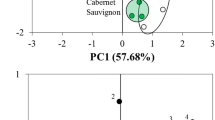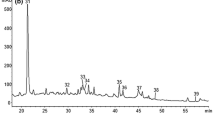Abstract
The aim of this study was to characterise and compare wines from different grape varieties focusing on the volatile phenols and on the respective precursor compounds, both on the free form (p-coumaric, ferulic and caffeic acids) and as tartaric esters of hydroxycinnamic acids (caftaric, coutaric and fertaric acids). Fifty-eight commercial monovarietal red wines from eight selected grape varieties were used: Cabernet Sauvignon, Syrah, Aragonez, Castelão, Touriga Franca, Touriga Nacional, Trincadeira and Vinhão (Sousão). It was found that volatile phenol precursors exist mostly as esters of tartaric acid, with caftaric acid as the most abundant cinnamate (17–111 mg/L), followed by coutaric and fertaric acids. The predominant hydroxycinnamic acid was p-coumaric acid, the highest concentrations being found in Syrah and Touriga Franca (6–7 mg/L) and the lowest in Touriga Nacional and Trincadeira (2–3 mg/L). Touriga Nacional exhibits the highest difference between bound and free forms. Malvidin-3-O-(6-p-coumaroyl)-glucoside, a potential source of p-coumaric acid, was found in most of the wines with average values varying between 1 and 5 mg/L. Twenty-two percent of the wines analysed presented levels of volatile phenols above the perception threshold. Ethylphenols were the highest in Vinhão and Trincadeira, showing an average value well above the perception threshold. The concentrations found in Cabernet Sauvignon and Syrah wines were around ten times lower than those reported in previous works. The results show relevant differences among grape varieties but the availability of the precursors in meaningful amounts may not be the only factor explaining the formation of volatile phenols in wines.





Similar content being viewed by others
References
Chatonnet P, Dubourdieu D, Boidron JN (1995) The influence of Brettanomyces/Dekkera sp. yeasts and lactic acid bacteria on the ethylphenol content of red wines. Am J Enol Vitic 46:463–468
Fugelsang K, Edwards C (2007) Wine microbiology, practical applications and procedures, 2nd edn. The Chapman & Hall Enology Library, London
Ribéreu-Gayon P, Dubourdieu D, Donéche B, Lonvaud A (2000) Handbook of enology volume II, the chemistry of wine and stabilization and treatments, 2nd edn. Wiley, Chichester
Wedral D, Shewfelt R, Frank J (2010) The challenge of Brettanomyces in wine. LWT Food Sci Technol 43:1474–1479
Heresztyn T (1986) Metabolism of volatile phenolic compounds from hydroxycinnamic acids by Brettanomyces yeast. Arch Microbiol 146:96–98
Macheix JJ, Fleuriet A, Billot J (1990) Fruit phenolics. CRC Press, Boca Raton
Hixson JL, Sleep NR, Capone DL, Elsey GM, Curtin CD, Sefton MA, Taylor DK (2012) Hydroxycinnamic acid ethyl esters as precursors to ethylphenols in wine. J Agric Food Chem 60:2293–2298
Edlin D, Narbad A, Dickinson JR, Lloyd D (1995) The biotransformation of simple phenolic compounds by Brettanomyces anomalus. FEMS Microbiol Lett 125:311–315
Chatonnet P, Viala C, Dubourdieu D (1997) Influence of polyphenolic components of red wines on the microbial synthesis of volatile phenols. Am J Enol Vitic 48:443–448
Loureiro V, Malfeito-Ferreira M (2006) Spoilage yeasts: Dekkera/ Brettanomyces spp. In: Blackburn C (ed) Food spoilage microorganisms. Woodhead Publishing Limited, Cambridge, pp 354–398
Pollnitz AP, Pardon KH, Sefton MA (2000) Quantitative analysis of 4-ethylphenol and 4-ethylguaiacol in red wine. J Chromatogr A 874:101–109
Goldberg DM, Tsang E, Karumanchiri A, Soleas GJ (1998) Quercetin and p-coumaric acid concentrations in commercial wines. Am J Enol Vitic 49:142–151
Shinohara T, Kubodera S, Yanagida F (2000) Distribution of phenolic yeasts and production of phenolic off-flavors in wine fermentation. J Biosci Bioeng 90:90–97
Nagel CW, Wulf LW (1979) Changes in the anthocyanins, flavonoids and hydroxycinnamic acid esters during fermentation and aging of Merlot and Cabernet Sauvignon. Am J Enol Vitic 30:111–116
Morel-Salmi C, Souquet J-M, Bes M, Cheynier V (2006) Effect of flash release treatment on phenolic extraction and wine composition. J Agric Food Chem 54(12):4270–4276
Nikfardjam MSP, May B, Tschiersch C (2009) 4-ethylphenol and 4-ethylguaiacol contents in bottled wines from the German ‘Württemberg’ region. Eur Food Res Technol 230(2):333–341
Oliveira CM, Barros AS, Silva Ferreira AC, Silva AMS (2015) Influence of the temperature and oxygen exposure in red Port wine: a kinetic approach. Food Res Int 75:337–347
Pati S, Crupi P, Benucci I, Antonacci D, Di Luccia A, Esti M (2014) HPLC-DAD–MS/MS characterization of phenolic compounds in white wine stored without added sulfite. Food Res Int 66:207–215
Cejudo-Bastante MJ, Pérez-Coello MS, Hermosín-Gutiérrez I (2010) Identification of new derivatives of 2-S-glutathionylcaftaric acid in aged white wines by HPLC DAD-ESI-MS. J Agric Food Chem 58:11483–11492
Guerrero RF, Liazid A, Palma M, Puertas B, González-Barrio R, Gil-Izquierdo A, García-Barroso C, Cantos-Villar E (2009) Phenolic characterisation of red grapes autochthonous to Andalusia. Food Chem 112:949–955
Rentzsch M, Wilkens A, Winterhalter P (2009) Non-flavonoid phenolic compounds. In: Moreno-Arribas MV, Polo C (eds) Wine chemistry and biochemistry. Springer, New York, pp 509–527
Singleton VL, Timberlake CF, Lea AG (1978) The phenolic cinnamates of white grapes and wines. J Sci Food Agric 29:403–410
Waterhouse AL (2002) Wine phenolics. In: Das DK, Ursini F (eds) Alcohol and wine in health and disease, vol 957. Annals of the New York Academy of Sciences, New York, pp 21–36
Ginjom I, D’Arcy B, Caffin N, Gidley M (2011) Phenolic compound profiles in selected Queensland red wines at all stages of the wine-making process. Food Chem 125:823–834
Soleas GJ, Dam J, Carey M, Goldeberg DM (1997) Toward the fingerprinting of wines: cultivar-related patterns of polyphenolic constituents in Ontario wines. J Agric Food Chem 45:3871–3880
Kallithraka SE, Tsoutsouras E, Tzourou E, Lanaridis P (2006) Principal phenolic compounds in Greek red wines. Food Chem 99:784–793
Avar P, Nikfardjam MSP, Kunsági-Máté S, Montskó G, Szabó Z, Böddi K, Ohmacht R, Márk L (2007) Investigation of phenolic components of Hungarian wines. Int J Mol Sci 8(10):1028–1038
Cabrita MJ, Torres M, Palma V, Alves E, Patão R, Costa Freitas AM (2008) Impact of malolactic fermentation on low molecular weight phenolic compounds. Talanta 74:1281–1286
Zoecklein BW, Fugelsang KC, Gump BH, Nury SF (1995) Wine analysis and production. Springer, New York
Boulton RB, Singleton VL, Bisson LF, Kunkee RE (1996) Principles and practices of winemaking. Chapman & Hall, New York
Arnous A, Meyer AS (2010) Discriminated release of phenolic substances from red wine grape skins (Vitis vinifera L.) by multicomponent enzymes treatment. Biochem Eng J 49:68–77
Chatonnet P, Dubourdieu D, Boidron JN, Pons M (1992) The origin of ethylphenols in wines. J Sci Food Agric 60:165–178
Acknowledgements
Adriana Lima hereby acknowledges the CNPq (National Scientific and Technological Council—Brazil) for research Grant funding (248796/2013-5). This work was supported by the project “Biological tools for adding and defending value in key agro-food chains (bio-n2-value)”, NORTE-01-0145-FEDER-000030. We would also like to thank the scientific collaboration of CBQF under the FCT (Portuguese national funding agency for science and technology) project UID/Multi/50016/2013. The authors are grateful to Teresa Brandão and Rita Monforte for advice and valuable help on statistical analysis.
Author information
Authors and Affiliations
Corresponding author
Ethics declarations
Conflict of interest
The authors declare that they have no conflict of interest.
Compliance with ethics requirements
This article does not contain any studies with human or animal subjects.
Rights and permissions
About this article
Cite this article
Lima, A., Oliveira, C., Santos, C. et al. Phenolic composition of monovarietal red wines regarding volatile phenols and its precursors. Eur Food Res Technol 244, 1985–1994 (2018). https://doi.org/10.1007/s00217-018-3110-8
Received:
Revised:
Accepted:
Published:
Issue Date:
DOI: https://doi.org/10.1007/s00217-018-3110-8




